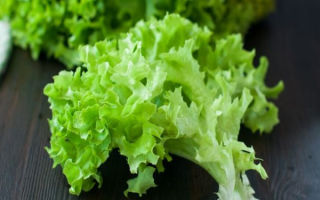Content
- 1 Description of lettuce
- 2 Composition and calorie content
- 3 Benefits for the body
- 4 Traditional medicine recipes from lettuce leaves
- 5 Application in cosmetology
- 6 Lettuce salad in cooking
- 7 Using lettuce seed oil
- 8 Tips for eating lettuce
- 9 Choosing and storing lettuce
- 10 Contraindications and possible harm
- 11 Conclusion
Fresh lettuce leaves are exquisitely decorated dishes to which they add a spicy taste. The benefits and harms of lettuce are well known. To have more advantages, you need to choose and use the right greens. If you do not take into account the characteristics of the organism (diseases, reactions to certain substances), then any plants or products can cause harm.
Description of lettuce
The exact place of origin of the culture is unknown. The name "lactuca" is translated from Latin as "milk". This is due to the fact that a little milky juice is released when the green mass breaks. Two types of plants are cultivated:
Lettuce salad sheet - wavy lush plates with a bland taste, elastic to the touch, but quickly fading. Therefore, fresh leaves are put in salads just before consumption. It is not recommended to store lettuce for a long time;

Head lettuce. Wavy elastic leaves form dense, light green heads of cabbage.

There are a variety of lettuce varieties on sale with interesting shades and shapes. In the retail chain, the plant is sometimes sold as an Iceberg salad. The most delicious is the Italian analogue "Radichye", with a characteristic light bitterness. The piquant taste is present in the French variety "Batavnya". For a long time it was believed that only seed oil was useful.

Composition and calorie content
The main composition of lettuce leaves per 100 g: water (95 g), a little fiber and glucose (1.0 g and 0.4 g, respectively). Of particular benefit to the plant is the presence of many vitamins, micro / macro elements such as:
|
Vitamins, mg |
Macro and microelements, mg |
|
A - 4 C - 9 K (phylloquinone) - 126 E - 0.2 B1 - 0.1 B2 - 0.1 B3 (niacin) - 0.4 B4 (choline) - 14 B9 (folic acid) - 38 |
potassium - 194 calcium - 36 sodium - 28 phosphorus - 29 magnesium - 13 iron - 1 manganese - 250 zinc - 0.2 selenium - 1 copper - 29 |
Caloric value: 12 kcal / 100 g (proteins 1 g, fats 0.3 g, carbohydrates 1 g).
Benefits for the body
Thanks to its rich set of chemical elements, lettuce eliminates inflammation. The diet of medical food includes green leaves to normalize the digestive system, in order to lower cholesterol levels. In the fight against atherosclerosis, overweight, insomnia, hypertension, leaves are also useful.
The benefits can be traced with the regular use of this greenery. It simultaneously increases appetite and promotes weight loss (thanks to its low calorie count).
Folic acid is useful for regulating metabolic functions. In addition, the immune system is strengthened and blood circulation is improved. Vitamin B9 is useful for establishing and restoring metabolic processes in both the male body and the female. But the special benefits of folic acid appear for a woman planning a pregnancy and in the first trimester.
In cosmetology, an extensive set of vitamins and microelements is also useful, since nails are strengthened, the healthy structure of the skin is restored (both oily and dry).
Traditional medicine recipes from lettuce leaves
Infusions and juices made from lettuce leaves have healing beneficial properties.For many years, these remedies were the main options with which it was possible to overcome the disease. Folk recipes are still useful and relevant.
Infusion
For some diseases, infusions from seeds or leaves of lettuce are used, they are necessary for such purposes as:
- to reduce cough, it is useful to drink an infusion of the leaves. To prepare a portion of the infusion, grind 20 g of fresh leaves and pour a glass of boiling water. Approximately 1.5-2 hours are defended and then filtered. It is useful to take 50 ml 3 times throughout the day;
- to get rid of insomnia, insist 20 g of crushed leaves in boiling water (250 ml). Withstand 25-30 minutes and filter. Leafy infusion (approximately 100 ml) is useful to drink before bedtime;
- to combat cystitis, insist 20 g of finely chopped leaves in boiling water (250 ml). After 2 hours, the infusion is filtered. It is useful to drink 100 ml a day.
Water infusions have a gentle effect on the human body, maintain its healthy tone.
The juice
The benefits of freshly made juices are undeniable, but it is harmful to store and heat the product for a long time.

Popular and healthy smoothie recipes:
|
Indications |
Ingredients |
Application methods |
|
Anemia |
100 ml of fresh carrot and asparagus juices 50 ml juice of lettuce leaves |
125 ml 2 times a day for 2 weeks |
|
Periodontal disease, bleeding gums |
freshly made juice |
rinse your mouth for about 30 seconds four times a day |
|
To normalize sleep |
dissolve 25 drops of juice in 100 ml of water |
3 times a day for 2 weeks |
|
Normalization of lactation |
50 ml lettuce juice 100 ml of carrot juice |
in the morning after eating for 1 week |
|
Rickets |
50 ml of turnip juice, lettuce leaves 20 ml dandelion juice |
consume 60 days for 1 tbsp. l 3 times a day |
Application in cosmetology
Recipes for home cosmetology will always be useful and in demand. Indeed, for the preparation of masks, decoctions, creams, fresh products are used and therefore such cosmetics bring more benefits than ready-made factory creams.
To stop hair loss, lettuce juice mixed with honey is rubbed into the scalp. It also helps fight dandruff.
Masks with crushed lettuce leaves are suitable for various purposes. For cooking, all components are loaded into a blender and beat for 1-2 minutes. The mixture is kept in the refrigerator for 5 minutes and applied to cleansed skin. Its benefits are as follows:
- to remove oily sheen from the skin, apply a mask of 1 tsp. grated lettuce leaves, mixed with finely grated half of a cucumber, 1 raw egg white. Add a teaspoon of lemon juice and finely chopped fresh mint;
- to restore the tone of aging skin, a mask of 2 tbsp is useful. l of leaves chopped on a grater, a tablespoon of fat sour cream and a couple of drops of olive oil;
- excellent remedy for skin recovery after sunburn. Stirred 2 tbsp. l pounded leaves and a spoonful of sour cream / kefir. This remedy is important on vacation, when you are near a pond, and the sun's rays negatively affect the skin.

Lettuce salad in cooking
The popularity of lettuce is not only due to its rich vitamin content. Juicy greens are great for decorating dishes. Leaves complement well not only fresh salads, but also snacks, sauces, soups, meat and fish dishes.
As an additional ingredient in salads, lettuce goes well with eggs, cucumbers, meat, and other greens and vegetables.
As an independent dish, a salad of finely torn lettuce leaves is served on the table, then seasoned with vegetable oil, mustard, onion, and garlic are added. Salt to taste, sprinkle with lemon juice, vinegar, season with finely chopped dill and parsley.

The lettuce puree soup is very healthy and popular as a first course. And boiled heads of cabbage perfectly serve as a side dish for meat and fish dishes.

Using lettuce seed oil
Lettuce oil is extracted from the seeds by cold pressing. The benefit of the oil is to restore the liver, improve the condition of the skin. Use the product both externally and internally for the following purposes:
- to normalize sleep, it is useful to drink 2 tbsp. l one hour before bedtime. To restore the nervous system, it is useful to take 3 tsp during the day;
- during massages, lettuce oil is used to normalize the performance of muscles and ligaments;
- Masks are useful for nourishing aging and dry skin.
The remedy is not considered a medicine, but it helps to fight insomnia, depression.
Tips for eating lettuce
It is helpful to use dark green leaves instead of pale leaves to create sap. A rich color indicates a high chlorophyll content.

For cooking, fresh leaves are taken, since wilted ones contain less vitamins and minerals. Lettuce salad is popular as a stand-alone meal (before the main meal) to help increase appetite. To obtain a pleasant taste, it is advisable to include no more than three types of greens in the salad.
Choosing and storing lettuce
In order for a salad to justify its nutritional value, you must carefully examine the greens before buying. It is necessary to adhere to the following recommendations:
- the stems should not be damaged, traces of mucus. A yellowish tint means a long shelf life of the product;
- leaves should be rich green and firm, not lethargic;
- depending on the variety, salads have different shades - from light green to brown with red.
If the salad is not used immediately, then it is stored in the refrigerator, but no more than 12 hours. The leaves are pre-washed, dried (shaken off, but not squeezed). Then they are put into a special container.

Contraindications and possible harm
A rich set of vitamins is undoubtedly of great health benefits. However, excessive consumption of greens, namely undiluted juice, can cause serious harm to people suffering from bronchial asthma.
Lettuce leaves, especially juice, are used with caution in chronic colitis and acute enterocolitis, exacerbations of gout, urolithiasis, and kidney disease.
Conclusion
The benefits and harms of lettuce can occur simultaneously. It's just that if you have certain diseases, you should carefully add salad to the diet. But it cannot be denied that even small portions of leaves or a few drops of oil are beneficial.

